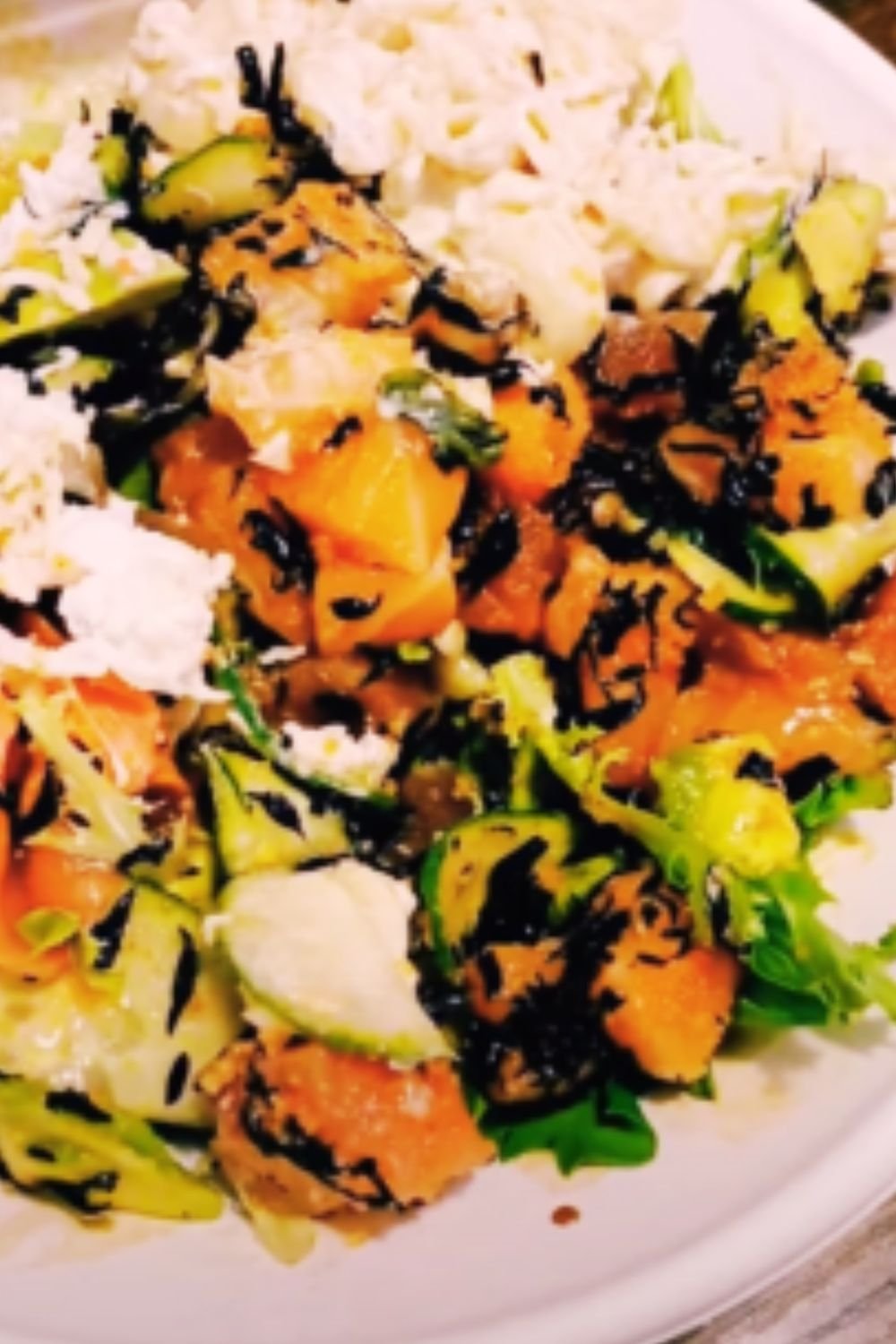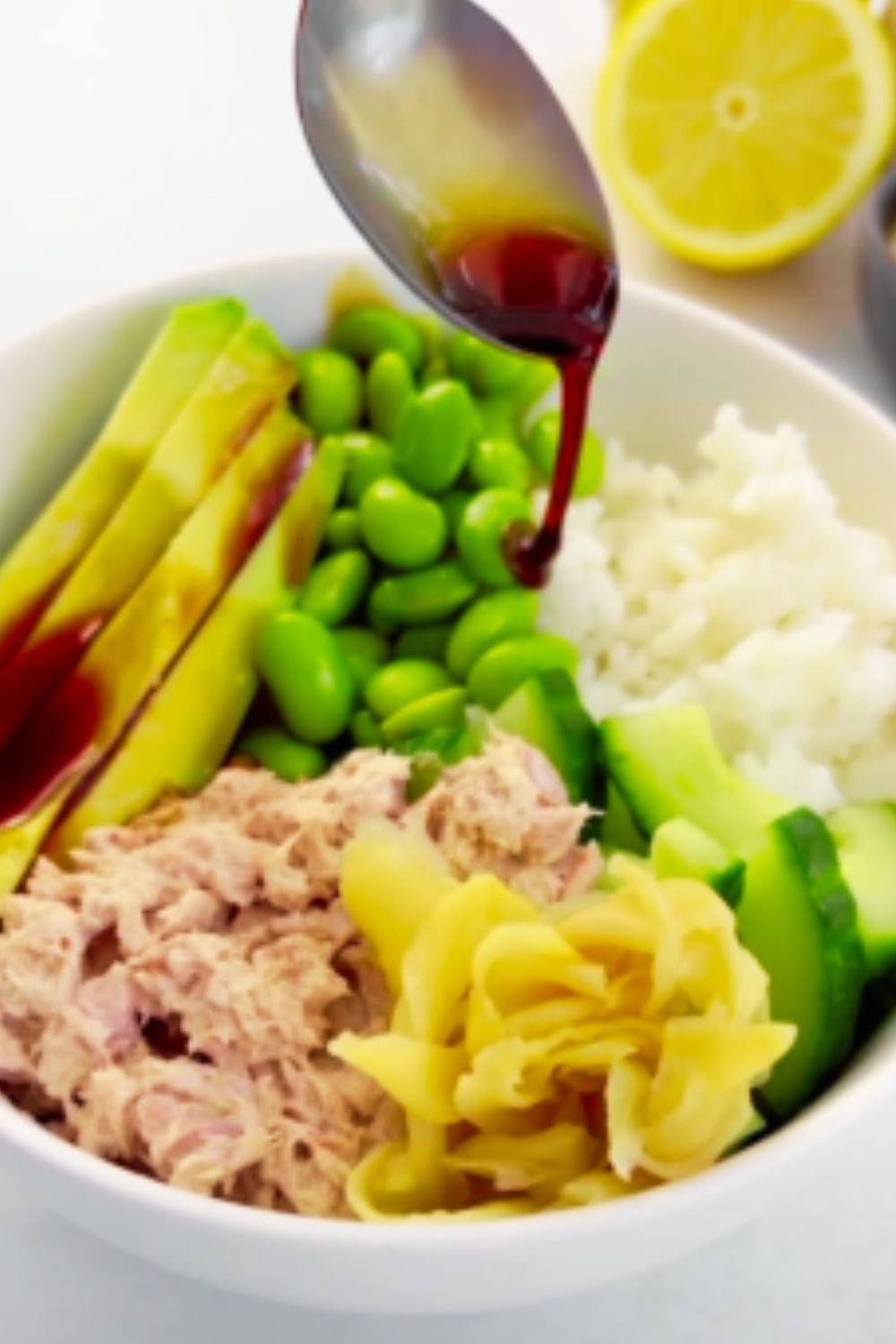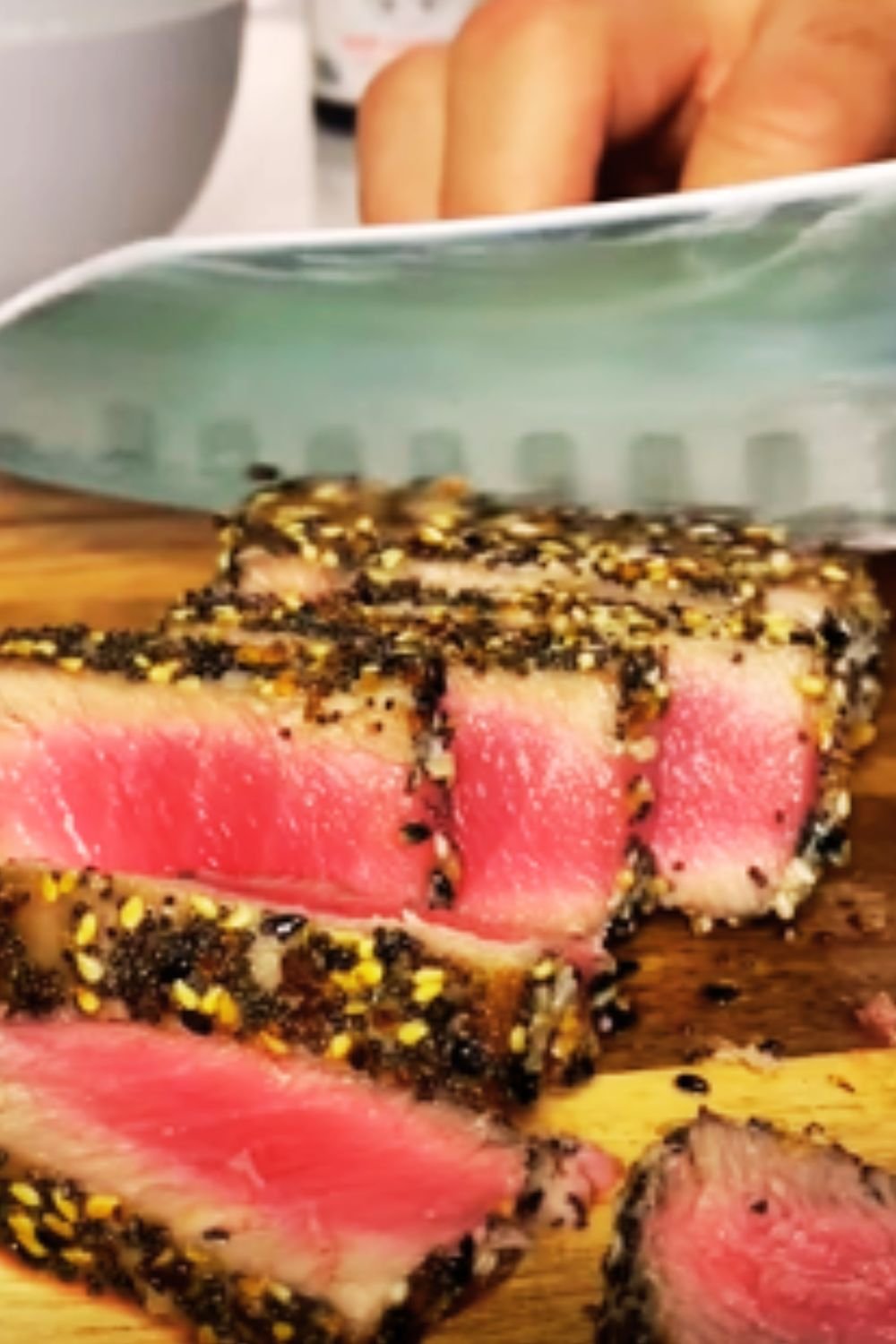There’s something magical about the first time you experience a truly exceptional poke bowl. I still remember mine – sitting on a wooden bench overlooking the Pacific Ocean in Hawaii, the fresh fish melting in my mouth while the salty breeze tousled my hair. That perfect harmony of flavors and textures changed my relationship with seafood forever. Today, I’m thrilled to share my ultimate tuna and salmon poke salad recipe that brings those vibrant Hawaiian flavors right to your kitchen.
Poke (pronounced poh-kay) means “to slice or cut” in Hawaiian, referring to chunks of raw, marinated fish – traditionally tuna – tossed with seaweed and sweet onions. While traditional poke has deep roots in Hawaiian cuisine, the dish has evolved dramatically in recent years, incorporating influences from Japanese, Korean, and mainland American cooking. My version combines the best of both worlds: honoring traditional techniques while embracing creative modern twists.
The beauty of this dish lies in its perfect balance – the buttery richness of salmon alongside the firm, meaty texture of tuna, brightened with zingy sauces and complemented by crisp vegetables. Whether you’re a seasoned poke enthusiast or a curious first-timer, this recipe delivers an explosion of flavors and textures that will transport you straight to island paradise.
The Perfect Poke: Understanding the Essentials
Before diving into the recipe, let’s cover some fundamentals that will elevate your poke game from good to extraordinary:
Fish Quality: This is non-negotiable. For raw preparations, you need sashimi-grade fish, which means the highest quality fish that’s been frozen according to FDA guidelines to kill potential parasites. Develop a relationship with a trusted fishmonger who can guide you to the freshest options.
Texture Balance: The magic of poke lies in the interplay of textures – the tender fish, crunchy vegetables, creamy avocado, and various toppings creating a symphony in each bite.
Flavor Layering: A great poke bowl builds flavors in stages – the marinade for the fish, the seasoning for the rice, and the final toppings and sauces all contribute to the depth of flavor.
Temperature Contrast: Serving room-temperature fish atop warm rice creates a pleasant contrast that enhances the eating experience.
Now, let’s get cooking!
Ingredients
For the Fish
- 8 oz sashimi-grade tuna, cut into ½-inch cubes
- 8 oz sashimi-grade salmon, cut into ½-inch cubes
- 3 tablespoons soy sauce (or tamari for gluten-free option)
- 2 tablespoons toasted sesame oil
- 1 tablespoon rice vinegar
- 1 teaspoon honey
- 1 teaspoon fresh ginger, finely grated
- 1 clove garlic, minced
- 1 scallion, thinly sliced (white and light green parts)
- 1 teaspoon toasted sesame seeds
- ½ teaspoon red pepper flakes (optional)
For the Rice Base
- 2 cups short-grain Japanese rice, rinsed until water runs clear
- 2¼ cups water
- 2 tablespoons rice vinegar
- 1 tablespoon sugar
- ½ teaspoon salt
For the Toppings
- 1 ripe avocado, diced
- 1 cucumber, seeded and diced
- 1 cup shredded carrots
- ½ cup edamame, shelled and cooked
- ¼ cup radish, thinly sliced
- 2 tablespoons pickled ginger
- 3 tablespoons furikake (Japanese seasoning)
- 1 sheet nori, cut into thin strips
- Microgreens for garnish
For the Spicy Mayo Drizzle
- 3 tablespoons mayonnaise
- 1 tablespoon sriracha (adjust to taste)
- 1 teaspoon lime juice
- ¼ teaspoon toasted sesame oil
Equipment Needed
- Sharp knife
- Cutting board
- Mixing bowls
- Rice cooker or medium pot with lid
- Wooden spoon or rice paddle
- Measuring cups and spoons
- Small bowl for mixing sauces
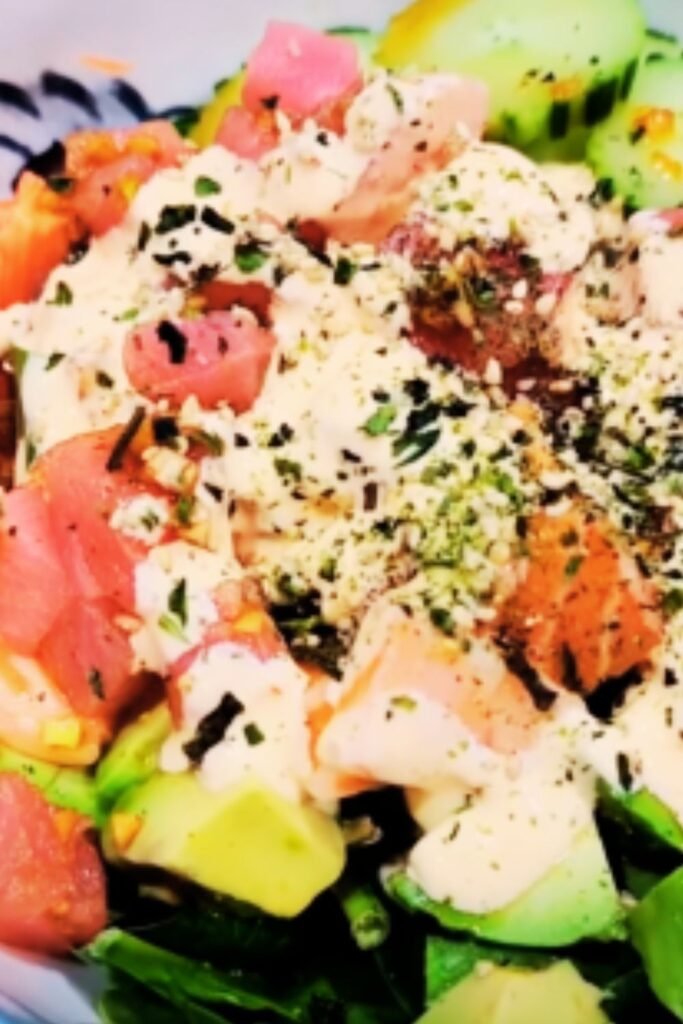
Preparation Method
Preparing the Rice
- Place rinsed rice and water in a rice cooker or pot
- If using a rice cooker, cook according to manufacturer’s instructions
- If using a pot, bring to a boil, then reduce heat to low, cover, and simmer for 15 minutes
- Remove from heat and let stand, covered, for 10 minutes
- While rice is still warm, mix rice vinegar, sugar, and salt in a small bowl until dissolved
- Gently fold the vinegar mixture into the rice with a cutting motion, being careful not to mash the grains
- Allow rice to cool to room temperature, but not cold
Marinating the Fish
- In a glass bowl, whisk together soy sauce, sesame oil, rice vinegar, honey, ginger, and garlic
- Place tuna in one bowl and salmon in another to maintain their distinct colors
- Divide the marinade between the two bowls, adding half to each type of fish
- Gently fold the marinade into the fish, ensuring each piece is coated
- Add half the scallions and sesame seeds to each bowl
- Cover and refrigerate for 15-30 minutes (no longer than 30 minutes or the acid will begin to “cook” the fish)
Preparing the Toppings
While the fish marinates, prepare all your toppings:
- Dice avocado and toss with a squeeze of lime to prevent browning
- Seed and dice cucumber
- Prepare carrots, edamame, and radish
- Mix ingredients for spicy mayo in a small bowl
- Transfer to a squeeze bottle or small plastic bag with corner snipped for easy drizzling
Assembling the Poke Bowls
The art of a beautiful poke bowl is in the assembly. I like to arrange components in sections rather than mixing everything together, allowing each ingredient to shine.
- Start with a base of seasoned rice in each bowl
- Arrange the marinated tuna and salmon in separate sections
- Add sections of avocado, cucumber, carrots, edamame, and radish
- Sprinkle with furikake and nori strips
- Add a small mound of pickled ginger
- Drizzle with spicy mayo
- Top with microgreens and additional sesame seeds
- Serve immediately
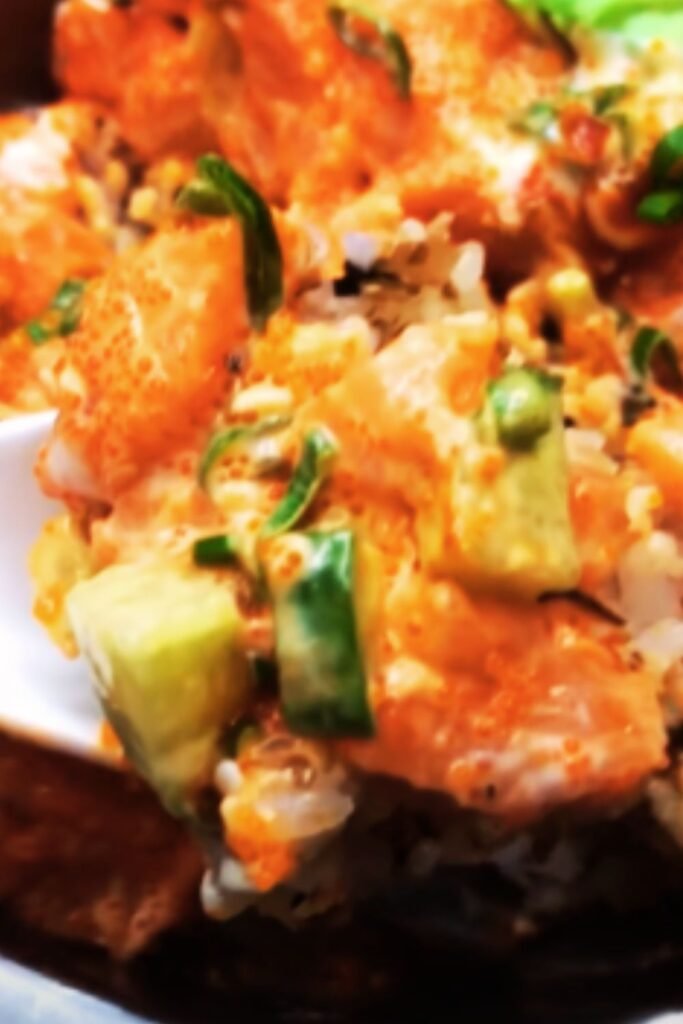
Nutritional Information
For those tracking their macros, here’s the nutritional breakdown per serving (recipe makes 4 servings):
| Nutrient | Amount per Serving |
|---|---|
| Calories | 520 |
| Protein | 32g |
| Carbohydrates | 56g |
| Fiber | 7g |
| Sugar | 6g |
| Fat | 24g |
| Saturated Fat | 3.5g |
| Omega-3 Fatty Acids | 1,800mg |
| Sodium | 850mg |
| Potassium | 720mg |
| Vitamin A | 85% DV |
| Vitamin C | 35% DV |
| Calcium | 8% DV |
| Iron | 15% DV |
Variations to Try
One of the joys of making poke at home is the ability to customize it to your preferences. Here are some creative variations to explore:
Base Options
- Brown rice for added fiber and nutty flavor
- Quinoa for a protein-rich alternative
- Zucchini noodles or cauliflower rice for a low-carb option
- Mixed greens for a lighter, salad-style poke
Protein Alternatives
- Hamachi (yellowtail) for a buttery texture
- Octopus (traditionally used in Hawaiian poke)
- Tofu (firm, pressed, and marinated) for a vegetarian option
- Cooked shrimp for those who prefer not to eat raw fish
Regional Flavor Profiles
Japanese-Inspired:
- Wasabi
- Ponzu sauce
- Shiso leaves
- Tobiko (flying fish roe)
Korean-Inspired:
- Gochujang (fermented chili paste)
- Kimchi
- Pickled daikon
- Gochugaru (Korean chili flakes)
West Coast Fusion:
- Mango
- Jicama
- Cilantro
- Jalapeño
Tips for Perfect Poke Every Time
Fish Selection and Handling
Fish quality and proper handling are crucial when preparing raw fish dishes. Here are my essential tips:
- Sourcing: Purchase fish explicitly labeled as “sashimi-grade” or “sushi-grade” from reputable fishmongers or Japanese markets.
- Smell Test: Fresh fish should smell clean, like the ocean – never “fishy.”
- Appearance: Look for firm flesh with vibrant color and no browning or discoloration.
- Temperature: Keep fish refrigerated until just before cutting.
- Cutting Technique: Use a very sharp knife and clean cutting board dedicated to seafood.
- Storage: Consume prepared poke within 24 hours and never refreeze previously frozen raw fish.
Knife Skills
Cutting fish properly makes a significant difference in the final texture of your poke:
- Cut against the grain for more tender pieces
- Aim for consistent ½-inch cubes for even marination
- Use a sharp, non-serrated knife to prevent tearing
- Chill the knife blade for cleaner cuts
Flavor Balance
The perfect poke has a harmonious balance of five key flavor elements:
| Flavor Component | Examples in Poke |
|---|---|
| Salty | Soy sauce, tamari, sea salt |
| Sweet | Honey, mirin, pineapple |
| Sour/Acidic | Rice vinegar, lime juice, yuzu |
| Umami | Fish, seaweed, soy, mushrooms |
| Spicy | Chili flakes, sriracha, wasabi |
For the most complex and satisfying flavor profile, try to include at least one element from each category.
Food Safety
When working with raw fish, food safety is paramount:
- Keep fish refrigerated until ready to use
- Use separate cutting boards and utensils for raw fish
- Wash hands thoroughly before and after handling raw fish
- Persons with compromised immune systems, pregnant women, young children, and the elderly should exercise caution with raw fish consumption
Make-Ahead Components
While the final assembly should happen just before eating, several components can be prepared in advance:
- Seasoned rice: Can be made up to 24 hours ahead and stored covered in the refrigerator. Bring to room temperature before serving.
- Vegetables: Can be cut and stored separately in airtight containers for up to 24 hours.
- Spicy mayo: Can be prepared up to 3 days ahead and stored refrigerated.
- Fish: Best prepared fresh, but can be marinated up to 30 minutes before serving.
Serving Suggestions
Poke bowls are a meal in themselves, but if you’re hosting a Hawaiian-themed dinner party, consider these complementary dishes:
- Miso soup as a starter
- Cucumber sunomono salad
- Hawaiian-style macaroni salad
- Fresh tropical fruit platter for dessert
- Sparkling water with fresh pineapple chunks and mint
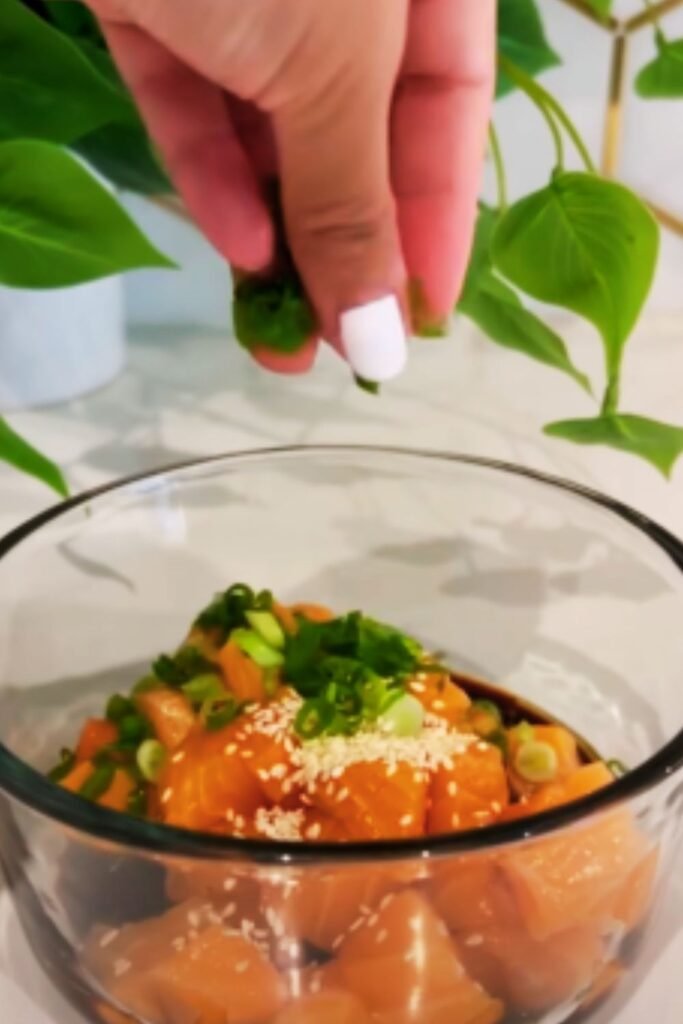
Seasonal Adaptations
Poke bowls can be adapted throughout the year to showcase the best seasonal produce:
Spring:
- Add snap peas and asparagus tips
- Incorporate fresh herbs like mint and chives
- Garnish with edible flowers
Summer:
- Add diced mango or peach
- Include sweet corn kernels
- Top with thinly sliced heirloom tomatoes
Fall:
- Add roasted sweet potato cubes
- Include pomegranate seeds
- Incorporate thinly sliced apple
Winter:
- Add quick-pickled butternut squash
- Include citrus segments
- Top with crispy Brussels sprout leaves
The Cultural Context of Poke
Poke has a rich cultural history in Hawaii, where it originated as a simple fisherman’s snack made from scraps of their catch mixed with sea salt, seaweed, and crushed candlenuts. Understanding this history helps us appreciate the dish more deeply.
Traditional Hawaiian poke was typically made with aku (skipjack tuna) or he’e (octopus). The dish we know today has evolved significantly, particularly since the 1970s when it gained popularity across the Hawaiian islands and eventually made its way to the mainland United States.
While I encourage creative interpretations, it’s important to acknowledge the dish’s origins and approach it with respect for its cultural significance. The recipe I’ve shared balances traditional elements with contemporary adaptations.
Common Questions and Answers
Q: How do I know if fish is sashimi-grade?
There’s no official “sashimi-grade” certification in the U.S., but this term generally indicates that the fish has been frozen according to FDA guidelines to kill potential parasites and is of the highest quality suitable for raw consumption. Always purchase from reputable sources and don’t hesitate to ask your fishmonger questions about the fish’s sourcing and handling.
Q: Can I make poke with frozen fish?
Yes, high-quality frozen fish that has been properly handled is actually safer for poke than “fresh” fish that hasn’t been frozen, as freezing kills potential parasites. Just ensure you’re using fish intended for raw consumption and thaw it properly in the refrigerator overnight.
Q: What are the best alternatives for people who don’t eat raw fish?
You can make delicious poke-style bowls with:
- Cooked and chilled shrimp or crab
- Seared tuna or salmon (cooked on the outside, rare in the center)
- Smoked salmon or trout
- Marinated tofu
- Cooked mushrooms seasoned with the same marinades
Q: How long can poke sit out at room temperature?
As with any raw fish preparation, poke should not sit at room temperature for more than 2 hours. For parties or gatherings, consider placing the serving bowl on ice to maintain food safety.
Q: Can I prepare poke bowls in advance for lunches during the week?
I don’t recommend preparing fully assembled poke bowls more than 24 hours in advance. However, you can prepare individual components separately and assemble just before eating. Keep the marinated fish separate from other ingredients until serving time.
Q: What’s the difference between poke and ceviche?
While both feature raw fish in small pieces, ceviche uses citrus juices to “cook” the fish through acidity, changing its texture and appearance. Poke uses minimal acid and maintains the raw texture of the fish. The marinades and typical accompaniments also differ significantly between the two dishes.
Q: How can I make this recipe more budget-friendly?
Sashimi-grade fish is admittedly expensive. To make this recipe more economical:
- Use one type of fish instead of two
- Increase the proportion of vegetables to fish
- Look for sales or specials at seafood counters
- Consider using high-quality canned tuna or salmon, though the texture will be different
Q: Is there a traditional Hawaiian poke recipe I should try first?
Traditional Hawaiian poke is delightfully simple. Try mixing cubed ahi tuna with Hawaiian sea salt (or flaky sea salt), chopped limu seaweed (or prepared seaweed salad), soy sauce, sesame oil, and chopped sweet Maui onion (or scallions). This lets you experience the clean, pure flavors that made poke beloved in the first place.
Final Thoughts
Creating the perfect poke bowl is both an art and a science. The combination of properly cut fish, balanced flavors, and complementary textures creates a dish that’s far more than the sum of its parts. As you become more comfortable with the basic technique, don’t be afraid to experiment with different fish, marinades, and toppings to create your own signature poke style.
What I love most about poke is how it connects us to Hawaiian culinary traditions while allowing for creative expression. Each bowl tells a story – of the ocean’s bounty, of cultural exchange, and of our own personal taste preferences.
Whether you’re making this tuna and salmon poke salad for a quick weeknight dinner, a special date night, or a gathering with friends, I hope it brings a taste of aloha to your table. The vibrant colors, fresh flavors, and nourishing ingredients make it a dish that feeds both body and soul.
